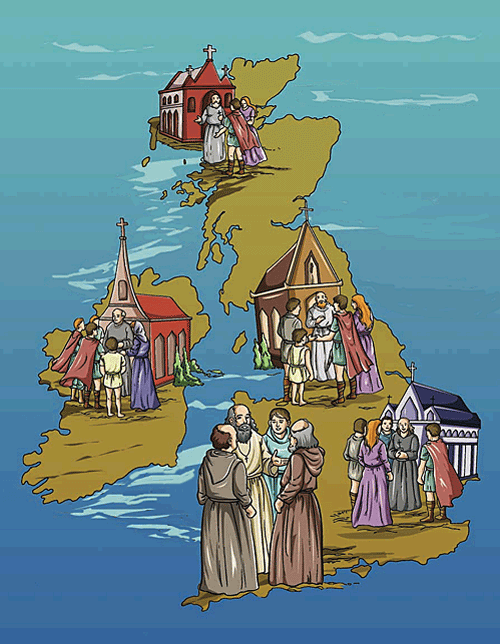English and Its Historical Development, Part 10B
(the revitalization of Christianity into the English culture did much to re-establish a significant number of Latin vocabulary into the English language)
In A.D. 597, St. Augustine arrived in England with 40 priests from Italy

All that remained of the Christian influence and Christian thought from the decades of the Roman occupation went northward and westward after the Teutonic invasions
Elements of the once well-established British church still remained in the outposts and hidden sanctuaries in the wilds of Wales; and the candles of faith were kept alight in Ireland by the disciples of St. Patrick and in Scotland by St. Columba from his rocky refuge on the isle of Iona off the stormy western coast.
The gulf between the warlike heathen Saxons and the warlike Christian Celts was too profound to be bridged until the advent of St. Augustine in Kent in A.D. 597.
The new faith was far from new in Britain, but this date of 597 marked the beginning of a systematic attempt on the part of Rome to convert the inhabitants and to make England a Christian country.
The spreading of the faith had an extensive effect on the language of the land. Latin words started to emerge from the cloisters and entered the everyday speech of the people.
Only a few were assimilated without change. Most of the words became adaptation to suit them to the Anglo-Saxon ear and tongue.
The spreading of the faith had an effect on the language of Britain because Latin was the language of learning and religion
It is significant that the Christian missionaries were allowed considerable freedom in their labors.
Within a hundred years of the landing of Augustine in Kent, all of England is said to have become Christian.
Latin words began to emerge from the cloisters and entered the everyday speech of the people. The introduction of Christianity meant the building of churches and the establishment of monasteries.
Latin, the language of the services and of ecclesiastical learning, was once more heard in England. Schools were established in most of the monasteries and larger churches.
Some of these became famous through the possession of great teachers and from them trained men went out to set up other schools at other centers.
To summarize, the church as the carrier of Roman civilization influenced the course of English life in many directions, and, as is to be expected, numerous traces of this influence are to be seen in the vocabulary of Old English
Such words as those which follow were just the beginning of the introduction of Latin into English:
- angel (Middle English), engel (Old English), Angelus (Latin)
- devel (Middle English), deofol (Old English), diabolus (Latin)
- priest (Middle English), preost (Old English), presbyter (Latin)
The Latin alphabet was brought over from Ireland by Christian missionaries. This has remained the writing system of English since that time.
Of about 30,000 words from the original Old English (Teutonic), only about 15 percent have survived the influences of time, change, Latin, and French.
These 15 percent remain the important basic building-blocks of our language: man, wife, child, house, eat, meat, sleep, fight, live, drink, father, sister, brother, numbers; such as 1-10, and basic grammatical elements; plus other essential words.
During this period, the vocabulary of Old English consisted of an Anglo Saxon base with borrowed words from the Scandinavian languages (Danish and Norse) and Latin.
Latin gave English words like "street, kitchen, kettle, cup, cheese, wine, angel, bishop, martyr, candle".
The Vikings added many Norse words: "sky, egg, cake, skin, leg, window" (wind eye), "husband, fellow, skill, anger, flat, odd, ugly, get, give, take, raise, call, die, they, their, them".
Celtic words also survived mainly in place and river names (Devon, Dover, Kent, Trent, Severn, Avon, Thames).
Many pairs of English and Norse words coexisted giving us two words with the same or slightly different meanings. Here are a few examples:
| Norse | English |
| anger | wrath |
| nay | no |
| fro | from |
| raise | rear |
| ill | sick |
| bask | bathe |
| skill | craft |
| skin | hide |
| dike | ditch |
| skirt | shirt |
| scatter | shatter |
| skip | shift |
From the introduction of Christianity in 597 to the close of the Old English period was over five hundred years
During all this time, Latin words must have been making their way gradually into the English language.
It is likely that the first wave of religious feeling which resulted from the missionary zeal of the seventh century, and which is reflected in the intense activity in church building and the establishing of monasteries during this century, was responsible also for the rapid importation of Latin words into English vocabulary.
Proceed to Part 10C, Caedmon A.D. 657-680.
INDEX or Table of Contents, English and its historical development.
References: sources of information.
